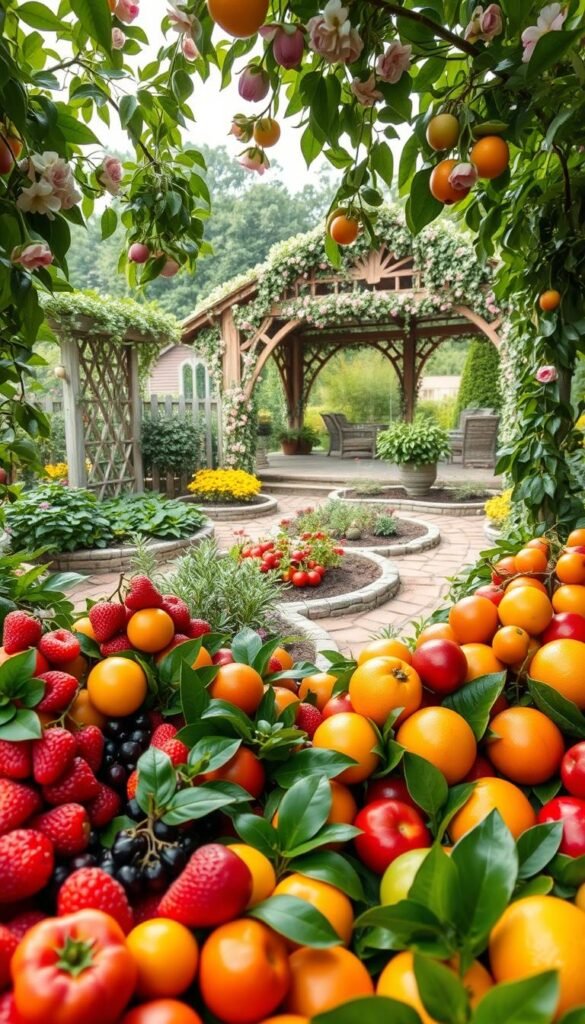Imagine stepping into your backyard and finding a vibrant space that delights the senses while nourishing your household. Modern outdoor areas are no longer just about looks—they’re about blending design with purpose. Today’s homeowners want landscapes that offer beauty and bounty, creating spaces where every plant serves dual roles.
Why are edible landscapes gaining traction? They merge sustainability with style, offering fresh produce without sacrificing visual charm. Think flowering apple trees or berry bushes that double as natural fences. Even compact yards can become productive havens with smart layouts and vertical growing solutions.
Success starts with intentional planning. Choose species that thrive in your climate while complementing your home’s architecture. Layer textures and colors—pair climbing grapes with fragrant herbs, or mix citrus trees with ornamental grasses. This approach ensures year-round interest, from spring blossoms to autumn harvests.
Ready to reimagine your space? Whether you’re crafting a cozy corner or revamping an entire yard, the key lies in balancing practicality with creativity. Your outdoor area can become a personalized retreat that feeds both body and soul.
Understanding the Appeal of a Fruit Garden Oasis
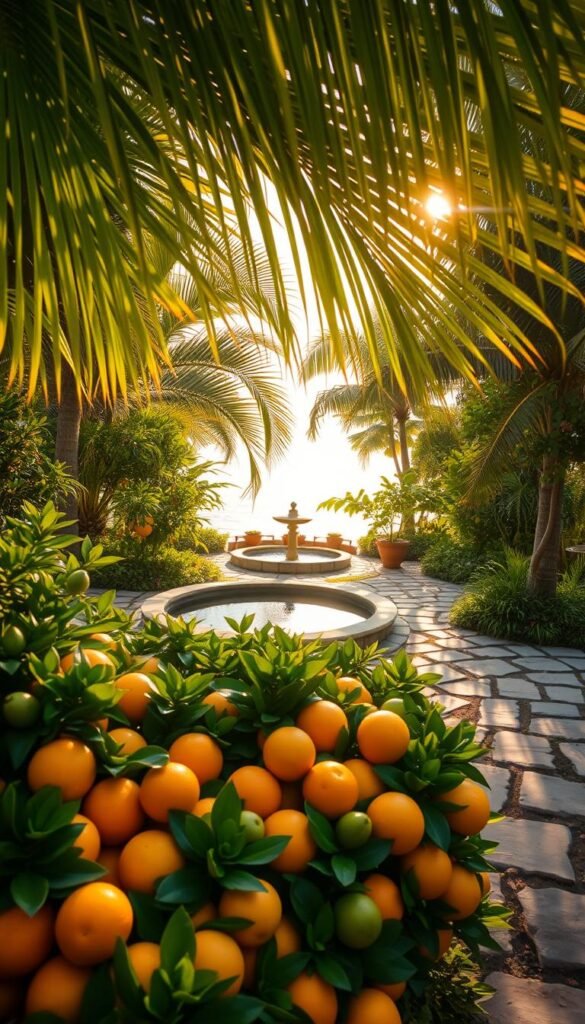
A well-planned garden space isn’t just pretty—it’s a living pantry bursting with color and flavor. By blending edible plants with thoughtful design, you create a retreat that evolves with the seasons. Spring cherry blossoms give way to summer berries, while autumn’s golden leaves frame ripe persimmons. Even winter brings structure through bare branches and evergreen herbs.
Growing food in your yard does more than cut grocery bills. Studies show tending plants reduces stress and fosters pride in nurturing life. Imagine plucking sun-warmed strawberries for breakfast or sharing homegrown figs with neighbors—these moments deepen your bond with nature.
Your home gains unique charm too. A pear tree archway or blueberry hedge adds curb appeal that standard lawns lack. Buyers increasingly value productive landscapes, making your space a smart investment. Plus, flowering varieties attract bees and butterflies, turning your yard into a mini wildlife sanctuary.
Families discover endless lessons here. Kids learn patience watching seeds sprout and excitement harvesting their first apple. Seasonal changes become tangible, connecting younger generations to Earth’s rhythms. Every visit outdoors becomes a chance to explore, taste, and grow—together.
Fruit Garden Inspiration: Aesthetic Upgrades and Decorative Details
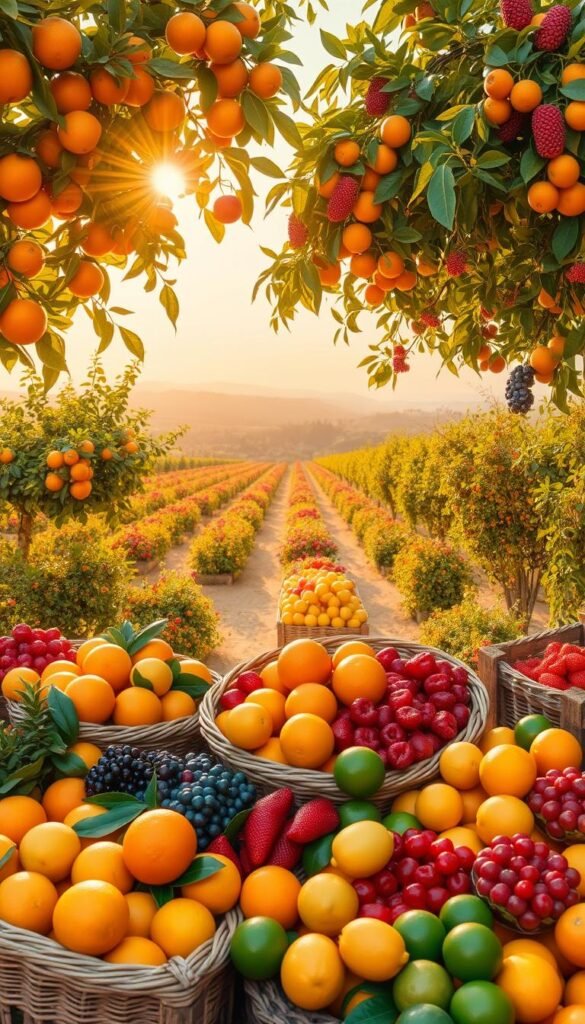
Turn your yard into a living canvas by choosing edible plants that dazzle with seasonal shifts. Vibrant blueberry bushes glow crimson in fall, while cherry trees shower spring pathways with pink petals. Even summer brings drama—think golden raspberries climbing lattices or fig leaves casting lacy shadows.
Espaliered trees transform blank walls into living art. Train apple or pear branches along wooden frames for structured greenery that saves space. These living sculptures yield snacks while framing views of your blooming garden.
Curate a year-round show with smart plant pairings. Mix early-blooming varieties with late-season stars to maintain visual flow. Check this table for ideas:
| Season | Plant | Visual Feature |
|---|---|---|
| Spring | Lemon Verbena | Fragrant white blooms |
| Summer | Goji Berry | Bright orange fruits |
| Fall | Aronia | Deep purple foliage |
Winding gravel paths invite exploration while showcasing your edible artistry. Place curved benches near strawberry towers or under grape arbors—perfect spots to enjoy nature’s theater. Rustic obelisks supporting kiwi vines double as vertical accents that draw the eye upward.
Layer textures by combining feathery dill with glossy citrus leaves. Dwarf peach trees make striking centerpieces when surrounded by low-growing thyme. Every corner becomes a photo-worthy scene that changes daily, proving practicality and beauty grow best together.
Mixing Edibles with Ornamentals for Dual-Purpose Beauty
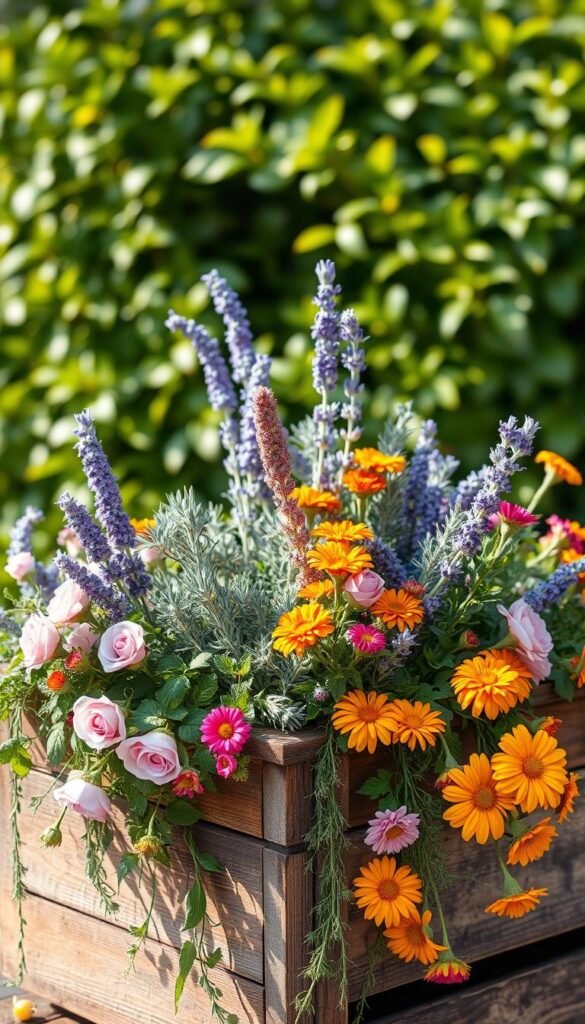
Why settle for separate spaces when your flower beds can mix dinner and décor? Traditional cottage style gardens perfected this art centuries ago, pairing kale’s ruffled leaves with roses or letting scarlet runner beans climb trellises beside peonies. The secret lies in choosing vegetables and herbs that rival blooms in visual impact.
Start by selecting edible plants with standout features. Purple basil’s glossy leaves create depth beside marigolds, while rainbow chard stems pop against lavender’s soft spikes. Look for varieties offering multi-season appeal—artichokes with architectural buds in spring and thistle-like flowers in fall.
Blur the line between functional and fancy by using edibles as design elements. Cabbage makes striking low borders, while climbing nasturtiums double as living mulch. Pair mint’s spreading habit with petunias in hanging baskets for cascading color that’s snackable too.
Smart pairings boost beauty and yields. Marigolds deter pests from tomatoes while echoing their golden hues. Tall dill adds airy texture to zinnia beds while attracting swallowtail butterflies. For continuous appeal, replace harvested lettuce with quick-growing alyssum—your salad bowl and flower display stay full.
Themed plantings tie everything together. Create a silver-toned bed with dusty miller, sage, and eggplant varieties. Or go bold with a “red revolution” section mixing strawberries, crimson cosmos, and ruby-red rhubarb. Your landscape becomes equal parts pantry and paradise.
Bold Use of Color and Texture in Your Garden
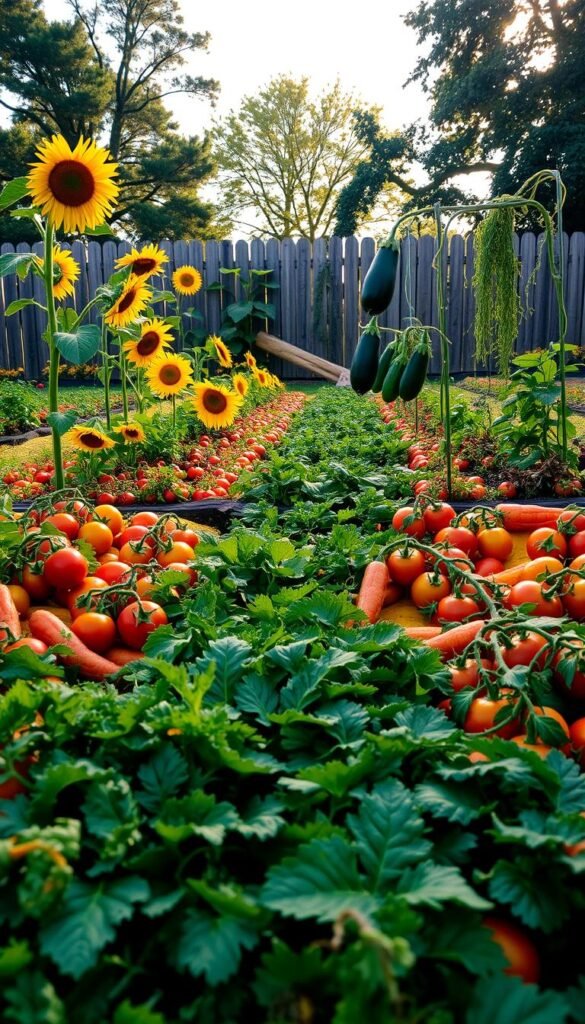
Transform your outdoor space into a vivid tapestry using edible plants that dazzle with both color and texture. Vibrant lettuces like ‘Merlot’ or ‘Outredgeous’ deliver deep red hues, while ‘Bull’s Blood’ beets add burgundy foliage. Even ornamental peppers like ‘Black Pearl’ bring jewel-toned leaves and fruits to the mix.
Crinkled kale varieties and ruffled cabbages create tactile depth. Their frilly edges catch sunlight, casting delicate shadows. Pair these with feathery mustard greens for contrast—soft meets structured in every bed.
Design seasonal stories through color shifts. Start with spring’s bright lettuces, transition to summer’s rainbow chard, then showcase autumn’s purple-stemmed amaranth. This progression keeps your house surroundings lively for months.
Layer heights for professional polish. Tall cornflowers frame mid-sized eggplants, while creeping thyme spills over borders. Vertical elements like trellised beans draw eyes upward without crowding compact areas.
Choose vegetables bred for beauty and flavor. ‘Sweet Pickles’ peppers offer edible confetti colors, while ‘Flashy Trout’s Back’ lettuce resembles living artwork. These dual-purpose picks prove practicality never sacrifices style.
Coordinate shades with your exterior palette. Match brick accents with crimson-stemmed rhubarb or echo shutters using indigo-hued kale. Your landscape becomes an extension of your home’s character—fresh, intentional, and irresistibly inviting.
Designing with Vegetable Varieties for Aesthetic Impact
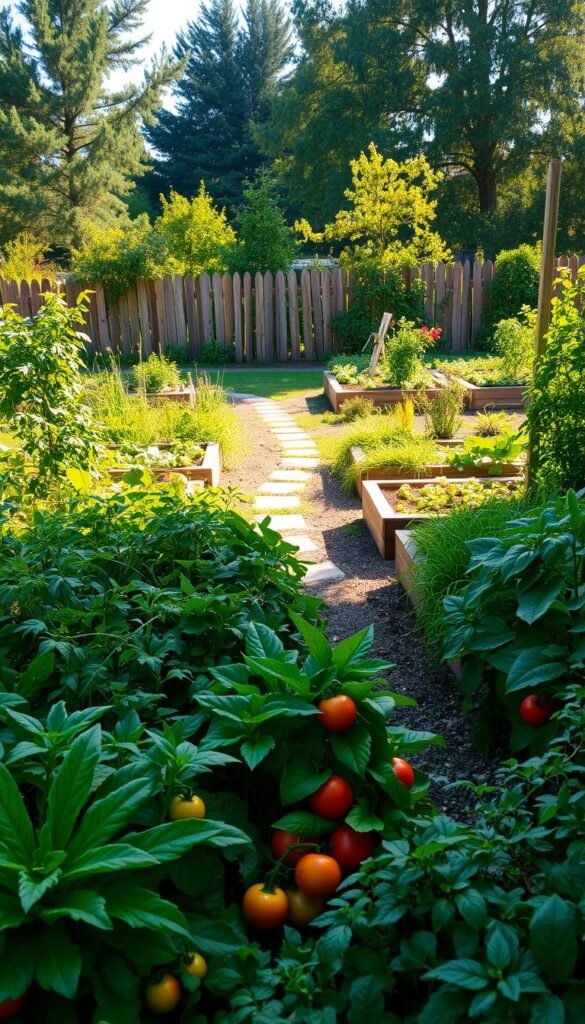
Your landscape gains depth when edible plants pull double duty as design stars. Brassica family members like kale and cabbage offer sculptural forms rivaling ornamental shrubs. Portuguese kale’s broad leaves create lush mounds, while ‘Redbor’ varieties shoot up to 4 feet, forming natural privacy screens.
Think vertically when planning your gardening layout. Towering Brussels sprouts develop knobby stems dotted with mini-cabbages—ideal for adding architectural drama. Surround them with low-growing herbs to frame their striking silhouette without crowding.
Key considerations for visual success:
- Space plants according to mature size—Russian kale needs 18-inch room, while Brussels sprouts demand 30-inch spreads
- Use red-stemmed chard or frilly lettuces as living borders along pathways
- Harvest strategically—remove outer kale leaves first to maintain the plant’s symmetrical shape
Brassicas shine brightest when treated as seasonal sculptures. Cabbage heads become rosette centerpieces, while frost-kissed kale develops jewel-toned leaves. These edible accents evolve through the seasons, proving vegetables can be both practical and picturesque.
Miniature Fruit Gardens: Ideas for Compact Spaces
Limited square footage doesn’t mean sacrificing homegrown goodness—just smarter layouts. Urban balconies, narrow side yards, and petite patios can all become productive growing zones with creative planning. The secret? Matching plant choices to your available space while using vertical techniques that multiply your harvest potential.
Transform unused strips along fences or driveways into lush walls of flavor. Espalier-trained trees thrive in 2-foot-wide areas, yielding 60-100 apples or pears from an 8-foot stretch. These living screens provide privacy while ripening snacks at arm’s reach.
Four-foot-wide planting beds offer surprising versatility. Dwarf apple varieties like ‘Urban Columnar’ grow just 2 feet wide but produce 20+ fruits annually. Pair them with blueberry bushes—their fall foliage adds crimson flair while delivering 4-6 quarts of berries each summer.
Even 2×2-foot corners contribute meaningfully. Compact gooseberry varieties, when pruned into upright forms, yield pints of tart-sweet gems. For larger circles (8 feet across), cluster 3-4 dwarf trees—peach, plum, and cherry varieties cross-pollinate while staying under 6 feet tall through seasonal pruning.
- Prioritize columnar or dwarf cultivars labeled for containers
- Use wall-mounted planters for strawberries or currants
- Schedule annual pruning to maintain scale and productivity
Containers expand possibilities for renters and apartment dwellers. Modern self-watering pots let citrus trees thrive on sunny decks, while hanging baskets brim with everbearing raspberries. Just remember: potted plants need more frequent watering and winter protection in colder zones.
Vertical Gardening: Trellises, Lattice Walls & Plant Supports
Turn unused vertical surfaces into thriving gardens with smart design solutions. By lifting crops upward, you free ground space while adding layers of visual depth. Structures like trellises and lattices become both functional supports and artistic statements in tight areas.
Trellis Creations for Climbing Vines
Arched metal or wooden frames instantly draw the eye while supporting beans, peas, or grapes. For balance, plant different varieties on each side—like scarlet runner beans paired with purple hyacinth vines. This creates a living canopy that filters sun while improving air circulation.
Consider materials that age gracefully. Cedar resists rot, while powder-coated steel offers modern flair. For a budget-friendly option, try DIY trellis projects using bamboo or repurposed ladders.
Green Wall Strategies for Maximizing Space
Lattice panels transform bland walls into edible tapestries. Train passionfruit or kiwi vines across grids, ensuring ties are loose enough for growth. Stagger plantings so mature leaves don’t block sunlight from younger shoots below.
“Vertical systems let you grow three times the produce in half the footprint.”
| Support Type | Best For | Maintenance Tips |
|---|---|---|
| Metal Obelisks | Cucumbers, small melons | Check for rust annually |
| Wire Grids | Peas, nasturtiums | Trim tendrils monthly |
| Wooden Pergolas | Grapes, kiwi | Re-seal wood every 2 years |
For quick results, mix fast-growing annuals like morning glories with perennial berries. Use removable clips to swap plants seasonally—snow peas in spring, Malabar spinach in summer. This keeps your vertical features productive year-round.
Incorporating DIY Garden Decor and Decorative Details
Personal touches transform ordinary spaces into cherished retreats. With simple materials and creativity, you can craft accents that reflect your home’s personality while supporting plant growth. These projects blend function with self-expression, turning overlooked items into conversation starters.
Handcrafted Sun Catchers and Wind Chimes
Craft sun catchers using wooden shapes coated in weatherproof paint. Add reflective beads to dance with sunlight, creating rainbows among your greenery. For wind chimes, repurpose silverware or seashells—their gentle tunes attract hummingbirds while masking urban noise.
Unique Planters and Upcycled Garden Accents
Breathe new life into forgotten objects. A rusty wheelbarrow becomes a strawberry planter, while vinyl gutters mounted on fences grow herbs vertically. Discover more DIY garden art projects using galvanized barrels or old drawers for quirky displays.
These creations prove beauty thrives when imagination meets practicality. Every brushstroke and repurposed product adds layers of meaning to your outdoor sanctuary.

